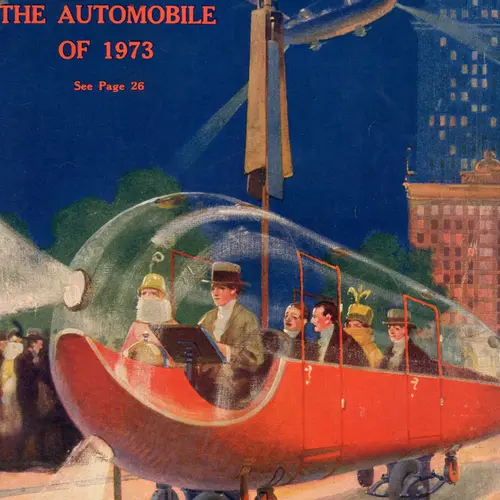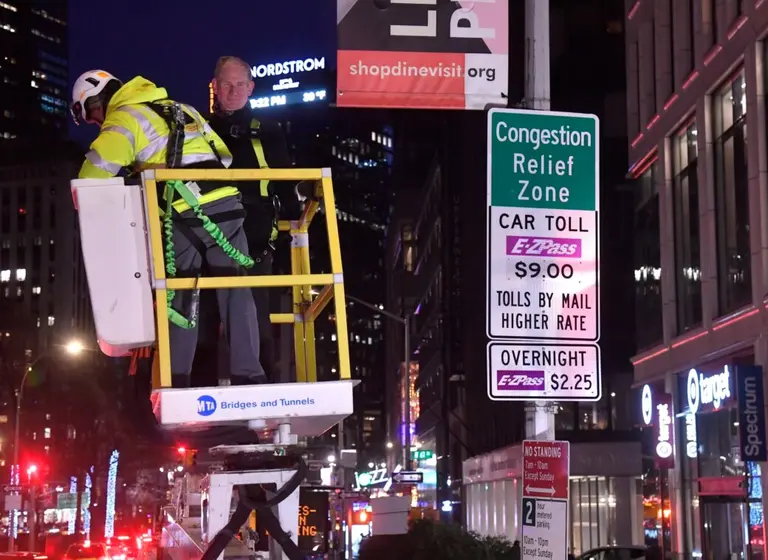In 1923, scientists thought flying cars would solve NYC’s traffic snarls by 1973

A 1923 cover of Science and Invention magazine imagined the flying automobile of 1973. Image via Smithsonian.
Back in May 6sqft reported on the futuristic, fantastic flying Uber; even in 2018, though it may have wings, so to speak, the idea is still one that belongs to the future. Back in 1923, it was predicted that by 1973, flying “helicars” would be buzzing travelers around New York City and the snarled traffic on the city’s roads would be a thing of the past.

A 1923 Rolls-Royce featured in the May 1923 issue of Science and Invention as part of the problem. Image: Wikimedia Commons via Smithsonian.
Cars were getting larger even then–and they would get a lot bigger before the advent of today’s more compact models–and traffic was a growing nuisance. Smithsonian magazine tells us about a vision of the future seen from 1923. The May 1923 issue of Science and Invention magazine featured on its cover a two-wheeled flying vehicle that was predicted as the answer to New York City’s car-packed streets. Called the “helicar,” the car was stabilized by gyroscopes and operated via control panel rather than steering wheel. Built of very light materials and encased in an “unbreakable, unburnable, glasslike substance,” the helicar was the vision of Hugo Gernsback, a writer and inventer who is known as the “father of science fiction.” Gernsback, for what it’s worth, also published the first science fiction magazine. A dedicated radio geek, Gernsback also opened the world’s first store specializing in radio at 69 West Broadway.
The Luxembourg native and 19-year-old New York transplant saw the future of major traffic congestion even in the 1920s, making the argument that tomorrow’s automobiles needed the option to fly above the city.
New York City is about to enact a law to eliminate a certain number of taxicabs, which now crowd the streets to such an extent that it is impossible to make any time at all in certain sections of the city. If you really wish to move rapidly, you have to take the subway or the elevated railway. This condition exists in most large cities. It has been proposed to build viaducts over the house tops, but due to the high cost it is doubtful if such a plan will ever become a fact, even in a time remote from now.
Gernsback felt the only real solution to New York’s traffic problem was the helicar, which he predicted would be in regular use by 1973 (keep in mind that in 1923 the helicopter wasn’t even considered a practical invention yet).
The only practical solution is to combine the automobile with an airplane and this no doubt will happen during the next few decades. The Helicopter Automobile or, for short, the helicar, will not take up very much more room than the present large 7-passenger automobile, nor will it weigh much more than our present-day car, but instead of rolling down the avenue, you will go straight up in the air, and follow the air traffic lines, then descend at any place you wish. This descent can be made in the middle of the street, if necessary. The car may roll through the street, and may rise in an open place, or square, of which there will be many in the future.
Gernsback predicted that the helicar would be “particularly useful for suburbanites to fly to and from work, and for pleasure.”
He suggested the helicar have two wheels instead of four: “A gyroscope keeps the car in an upright position at all times, and makes riding on two wheels perfectly safe.” He also cites the bicycle as a perfectly good two-wheeled invention.

Features of the 1973 flying car as imagined in 1923. Image: Wikimedia Commons via Smithsonian.
(1) — Push button power control board before driver, which also switches power to helicopter drive shaft (3), and blades (9), when it is desired to fly.
(2) — Steering wheel.
(3) — Helicopter drive shaft.
(4) — Gyroscope for stabilizing car on two wheels.
(5) — Twelve cylinder gasoline engine driving large dynamo (6), which supplies electric current to motor within rear wheel, (13).
(6) — Dynamo (electrical generator).
(7) — Storage battery for engine and radio receiving and transmitting set, (8).
(8) — Radio set.
(9) — Collapsible helicopter blades. (Note: Engine driven.)
(10) — Powerful electric lamps and reflectors for flying purposes.
(11) — Elevating wings controlled by driver, used in ascending or descending, as well as tail, (12).
(12) — Helicopter tail.
(13) — Electric motor wheel, which drives the car along the road when not in the air.
(14) — Motor driven spur wheels which can be lowered to assist in propelling the car out of icy spots.
(15) — Collapsible steps.
(16) — Fender.
(17) — Electric headlight used when running on road.
Gernsback also believed that we would have kicked our dependency on gasoline by the year 1973: “In our illustration we have shown a gasoline engine as the driving agent for the Helicar. There is no reason why a gasoline engine should be employed. Perhaps by that time we will be extracting electricity from the air, and merely use an electric motor to run the car, or we may even approach the point where the wireless transmission of energy will be a proven fact.”
Gernsback died in 1967 at the age of 83, but we think he’d be disappointed in just how far we haven’t come when it comes to transportation. As we continue to search for ways to lessen the never-ending snarl of city traffic, we’re looking to the modern-day versions of the helicar being developed by Uber and NASA, thinking they couldn’t touch down a moment too soon.
[Via Smithsonian]
RELATED:






























